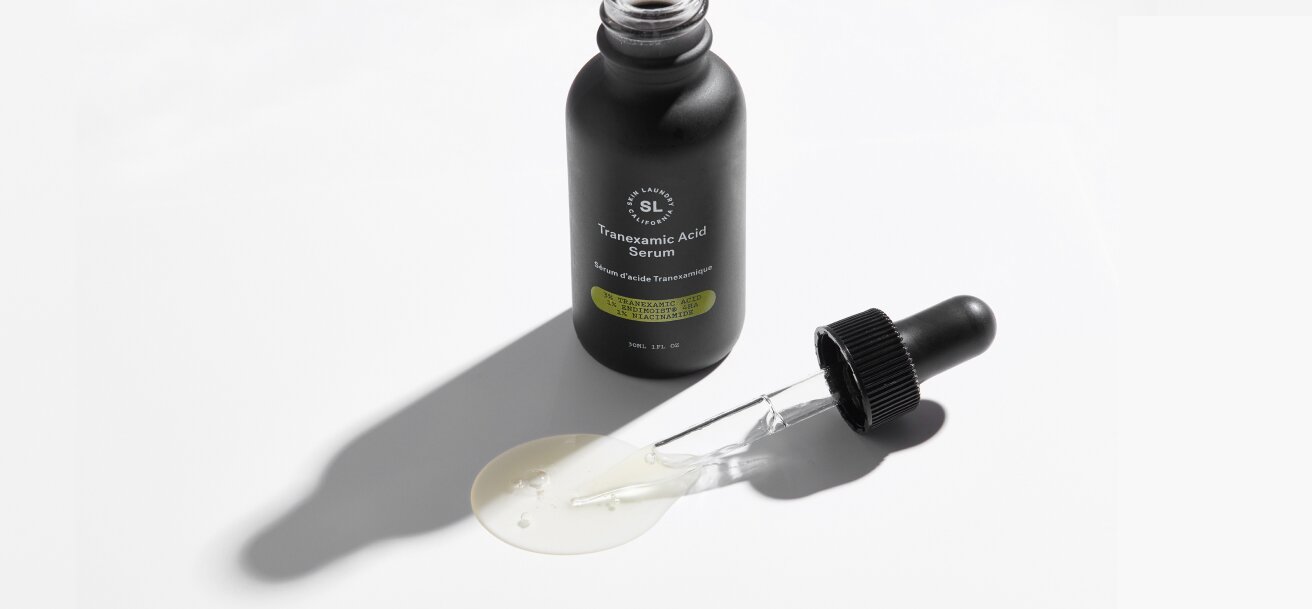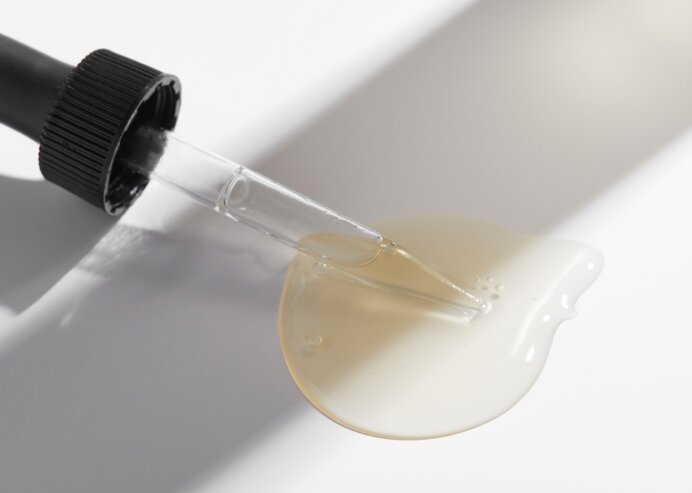Terms

INGREDIENTS
All About Tranexamic Acid
How this hero ingredient helps reduce the appearance of melasma, hyperpigmentation and rosacea
When it comes to brightening skincare ingredients, many can be drying, irritating and unsuitable for sensitive skin. Enter Tranexamic Acid, safe for all skin types and non-irritating, when applied topically this ingredient is highly effective at treating hyperpigmentation, melasma and even rosacea, delivering a more even skin tone, less redness and supporting the skin barrier.
Read on for our Skin Laundry guide to Tranexamic Acid.
What is Tranexamic Acid ?
Tranexamic Acid is an ingredient derived from the amino acid lysine that prevents melasma by inhibiting the development of skin hyperpigmentation and reducing tyrosinase activity (the enzyme that catalyzes the production of melanin).
At the same time, it blocks the transfer of pigment from melanocytes (pigment-producing cells) to keratinocytes (the keratin-synthesizing cells found in the outermost layer of skin – the epidermis). Tranexamic Acid also decreases the skin’s sensitivity to UV.
Tranexamic Acid Skincare Benefits
- Tranexamic Acid helps prevent the formation of dark spots while actively improving existing discoloration.
- Tranexamic Acid helps fade the look of post-breakout marks of any color for all skin tones.
- Tranexamic Acid helps visibly reduce redness and may minimize the appearance of rosacea.
- Tranexamic Acid is a well-tolerated ingredient that is non-irritating and safe for all skin types.
- Tranexamic Acid has comparative benefits to other dark spot-diminishing creams (such as Hydroquinone) but is less irritating and safe for all skin tones.
What skin conditions does Tranexamic Acid treat?
Hyperpigmentation
Hyperpigmentation is a term that describes a variety of skin conditions that produce dark patches. This is the result of your body producing an excess of melanin, the natural pigment that gives your skin its color.
A number of factors can trigger an increase in melanin production, but the primary causes are sun exposure, hormonal influences, age and skin injuries, or inflammation.
The three main types of hyperpigmentation are age spots, melasma, and post-inflammatory trauma. Post-inflammatory trauma can result from an injury, sun exposure, or a skin condition, such as acne.
Tranexamic acid is a highly effective ingredient for reducing hyperpigmentation, whether caused by sun exposure, acne scarring or hormonal changes. Unlike exfoliating acids that simply lift away surface pigment, tranexamic acid targets the root cause by interrupting the pathways that trigger excess melanin production in the skin. This helps fade dark spots, prevent new discoloration from forming and promote a more even, radiant complexion.
Melasma
Melasma is a common skin condition in which light to dark brown or greyish pigmentation develops on the face. Although it can affect all skin types and tones, it is more common in women, especially those with darker skin tones. Melasma usually becomes more noticeable in the summer and improves during the winter months.
According to the American Academy of Dermatology, common melasma triggers include:
- Sun exposure: Ultraviolet (UV) light from the sun stimulates the melanocytes. In fact, just a small amount of sun exposure can make melasma return after fading. Sun exposure is why melasma is often worse in the summer. It also is the main reason why many people with melasma get it again and again.
- A change in hormones: Pregnant women often get melasma. When melasma appears in pregnant women, it is called chloasma, or the mask of pregnancy. Birth control pills and hormone replacement medicine also can trigger melasma.
- Skin care products: If a product irritates your skin, melasma can worsen.
Tranexamic acid has become a breakthrough ingredient in the treatment of melasma. Unlike traditional brightening agents, tranexamic acid works by interfering with the skin’s pigmentation process at a cellular level. It helps block the interaction between UV light, hormones and melanocytes (the pigment-producing cells), which reduces excess melanin production and prevents dark patches from worsening. When used consistently in topical skincare, tranexamic acid can significantly lighten discoloration, improve skin tone uniformity,
Rosacea
Rosacea is a common skin condition that causes redness and visible blood vessels on the cheeks, nose, chin and forehead. Commonly mistaken for acne or eczema, rosacea affects all skin tones, although it is most common in women aged forty to sixty with fairer skin tones.
The cause of rosacea is not yet fully understood but it is thought to be a result of a combination of hereditary and environmental factors. While there is no cure for rosacea, there are skincare products and treatments that can alleviate, manage and even reverse the symptoms.
For those struggling with rosacea, tranexamic acid offers a calming and restorative approach to managing persistent redness and skin sensitivity. This powerhouse ingredient works by reducing the activity of plasmin, a protein involved in inflammation and blood vessel dilation, both of which contribute to the visible flushing and irritation seen in rosacea-prone skin. By soothing inflammation and strengthening the skin barrier, tranexamic acid helps minimize redness, even out skin tone and improve overall skin resilience.

How to incorporate Tranexamic Acid into your skincare routine
Tranexamic Acid, which usually comes in the form of a serum, can be incorporated easily into your regular skincare routine after cleansing and before applying your moisturizer.
Our Skin Laundry Tranexamic Acid Serum improves the appearance of dark spots and discoloration, targets melasma and hyperpigmentation, and reduces the appearance of uneven skin patches.
*If pregnant, please do not use Tranexamic Acid.
Discover our line of dermatologist-approved skincare products.
Doctor's Note
Start by using this ingredient gradually, for example twice a week, to see how your skin responds. If your skin shows no irritation, you can use Tranexamic Acid as either part of your morning or evening skincare routine.
Additional Reading
Your Shopping Bag
Your shopping bag is empty











